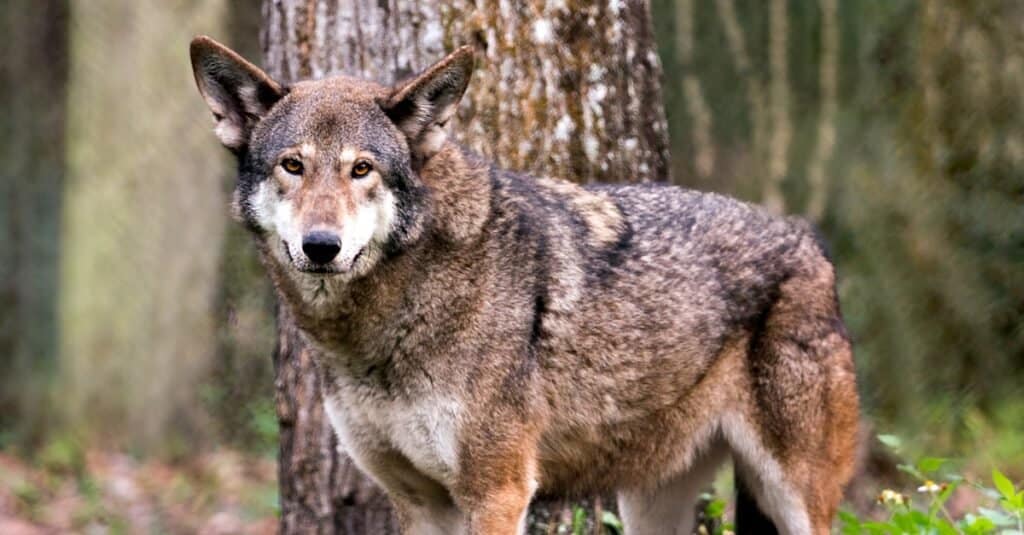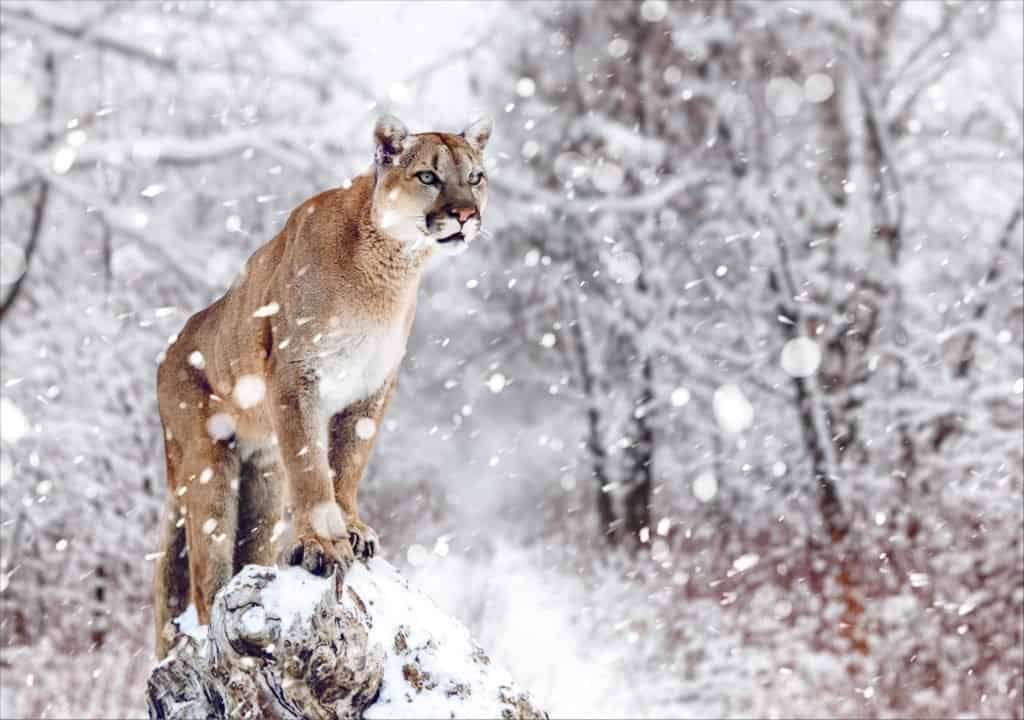Massive felines and canines share ranges and battle one another all the time. Sometimes the big cat gets the upper hand, and other times groups of canines bring them down. We’ve already shown you what would happen if a mountain lion and coyote fought. Yet, what would happen if the coyote’s larger relative, the wolf, decided to fight against a mountain lion? We’re going to examine a mountain lion vs wolf fight from several perspectives. By looking at the available data, we’ll be able to say with some certainty which of these animals is most likely to win a battle against the other.
Comparing a Mountain Lion and a Wolf

| Mountain Lion | Wolf | |
|---|---|---|
| Size | Weight: 60lbs-198lbs Length: 5ft-8ft Height: 2ft-3ft at the shoulder | Weight: 80-150lbs Length: 3.4ft – 5ft Height: 2.2ft – 3ft |
| Speed and Movement Type | – 30 mph | – 35 mph |
| Defenses | – High speed – Large size – Good senses | – Safety in numbers in its pack – Large size – Speed to run away from danger |
| Offensive Capabilities | – Powerful biting force, but not as strong as a lion – Bite power below 650 PSI – Very powerful jaws – Long teeth – 2.5-inch claws | – 400 PSI bite force, perhaps up to 1,000 – 2-inch teeth – Powerful senses of smell, sight, and hearing to help identify prey from far off |
| Predatory Behavior | – Ambush predator that wraps its forelegs around prey and takes them to the ground – Very quiet hunters that stalk potential prey before attacking | – Persistence hunting tires out the prey animal before killing it |
What Are the Key Differences Between a Mountain Lion and a Wolf?

Wolves are deadly hunters when they work in packs.
©Rejean Bedard/Shutterstock.com
The greatest differences between a mountain lion and a wolf include their size, speed, and predatory behavior. Mountain lions are ambush predators that weigh between 60 lbs and 198 lbs and run 30 mph, but wolves are persistent predators that weigh between 80 lbs and 150 lbs and reach top speeds of 35 mph.
The unique qualities of these animals set them apart as hunters and will certainly impact the outcomes of this battle. We’ll explore additional factors that will change the impact of the right as well. By the time we’re finished, we’ll know which mammal is poised to win.
What Are the Key Factors in a Fight Between a Mountain Lion and a Wolf?

Wolves are fast creatures with a lot of endurance.
©Holly S Cannon/Shutterstock.com
The key factors in a fight between a mountain lion and a wolf are similar to other battles in the animal kingdom and include size, fighting abilities, and defenses. We are going to examine these elements and others, and we’ll assign advantages to each creature. Once we have finished comparing the mountain lion and wolf in this manner, we can declare a winner of this battle!
Mountain Lion vs Wolf: Size
Mountain lions are larger than wolves on average. Wolves can weigh 80lbs-150lbs on average, growing up to 5ft long and standing between 2ft and 3ft tall. Mountain lions can reach a weight between 60 lbs and 198 lbs. They can also grow up to 8ft long and reach heights between 2ft and 3ft. Thus, a mountain lion is longer and heavier than a wolf, but they are the same height.
Mountain lions have an advantage in terms of size.
Mountain Lion vs Wolf: Speed and Movement
Wolves can run faster than mountain lions. These canines can reach speeds of 35-40 mph when running at their fastest, and they have amazing stamina too. Mountain lions can tear after their prey at speeds of 30 mph. That’s fast, but not faster than the wolf.
Wolves have a speed advantage over mountain lions.
Mountain Lion vs Wolf: Defenses
As a solo creature, the mountain lion has equal defenses to a wolf. They have their speed, size, and senses to keep them safe from prey. Wolves rely on their pack for protection, and that’s a great form of safety to have. They can also scare prey off with their size or escape from trouble with their speed.
Both mammals have similar defenses, so this is a tie.
Mountain Lion vs Wolf: Offensive Capabilities
Wolves primarily rely on their teeth to do damage to enemies. They have 2-inch teeth and jaws that generate between 400 and 1,000 PSI for bites. They also have amazing senses to help them locate and start to pursue prey.
Mountain lions are known for having a strong bite, but one that is below 650 PSI. They have long teeth and 2.5-inch claws that are far sharper than most creatures. A mountain lion will typically use its forelegs and claws to pin prey and its teeth to bite them to death.
A mountain lion has a better arsenal of offensive weapons to attack with than a wolf.
Mountain Lion vs Wolf: Predatory Behavior
Wolves tend to hunt in packs, and they use persistent hunting to bring down their prey. That means they swarm over their prey, wear it down, and then move in for the kill. This process can take several minutes and relies on them using their stamina and teeth to sap the prey.
Mountain lions are ambush predators that stalk prey, lunge at them, dig in their claws, wrap the prey up so it can’t move, and then bite into the skull. The massive trauma from this bite kills the prey, but they will also go for the throat if the battle continues longer than the initial bite.
A mountain lion has better predator behaviors than a lone wolf.
Who Would Win in a Fight Between a Mountain Lion and a Wolf?

In this case, a mountain lion’s power and precision are too hard for the wolf to overcome.
©Unknown/Shutterstock.com
A mountain lion would win a fight against a wolf. Mountain lions have a size advantage, a power advantage, and more weapons in their arsenal to kill a wolf. If the mountain lion successfully ambushed a wolf, the fight is immediately over, and the wolf is dead due to a pierced skull or ripped throat.
The two animals may meet on an even playing field though. In that case, the wolf would try to harry the mountain lion using its superior speed. That’s a good technique, but if the mountain lion can counter, which it will with its agility, then the wolf is going to give as good as it gets on every exchange.
The wolf has to bite to hurt the mountain lion. The mountain lion can use its deadly claws at a range to hurt the wolf and it can use its powerful bite. At some point, the two would probably exchange bites, and the long teeth, precision, and cunningness of the mountain lion would allow that animal to come out on top.
Could Another Animal Take Down a Mountain Lion?
Even though they were competitive in size and ferocity – the mighty mountain lion was just too much for the big bad wolf. How would a lion do against a fierce predator with more bulk and possessing a different set of skills? Could a mountain lion defeat a bear in a fight?
Bears are much larger than mountain lions – weighing 700 pounds to the lion’s 130. But is size the only factor? What about speed? Believe it or not – a bear is actually faster than a mountain lion – reaching speeds of up to 35 mph. Mountain lions can run 30 mph but their amazing agility could put them over the top.
Both animals use their incredible bite force and razor-sharp claws to take down prey with astonishing success. Their fighting styles, however, couldn’t be more different. Like all cats, mountain lions silently stalk their prey and exercise phenomenal patience to wait for just the right moment to pounce. They wrap their powerful front legs around the animal and dig in their sharp claws before they deliver one killing bite to the neck. Bears, on the other hand, charge and overpower their prey before mauling them to death.
In a knock-down, drag-out fight between a mountain lion and a bear – the bear would stand its ground and overwhelm the smaller lion within minutes. The mountain lion would surely land a few blows and bites – but the big bear would come out bloodied but on top. No contest.
The photo featured at the top of this post is © Scott E Read/Shutterstock.com
Thank you for reading! Have some feedback for us? Contact the AZ Animals editorial team.






